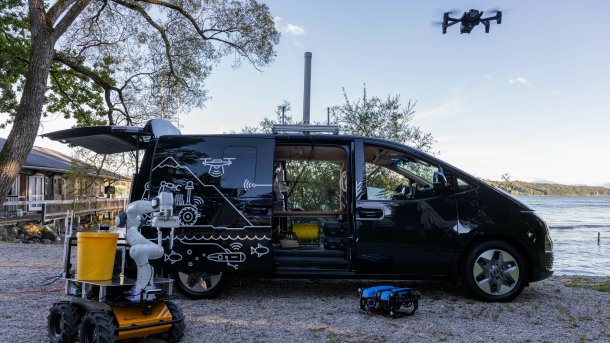TU Munich: Robots and drones to monitor and clean the environment
Researchers at the Technical University of Munich have set themselves the goal of cleaning the environment with robots and drones. This is done remotely.

The SVan serves as a mobile hub from which the robots and the drone start the remote-controlled environmental cleaning.
(Bild: Get Flashed Media)
Can human efforts in the area of the environment - such as monitoring and cleaning it - be scaled up and made more effective with the help of robots, artificial intelligence (AI) and machines? Researchers at the Technical University of Munich (TUM) are convinced of this and have therefore been developing a technology platform for environmental robotics at the TUM Institute MIRMI (Munich Institute of Robotics and Machine Intelligence) for around four years. In an initial implementation, it can already be used to control robots and drones via telepresence and directly on site.
Because environmental robots are needed in many places, the platform and its robots are housed in a mobile Hyundai Staria van. The "guardians", as the robots and drones at MIRMI are called, use this vehicle, known as the SVan (Synchronous Team Robot Van), as a mobile hub and charging station for the robots. It is also a control and command station with a 5G mobile radio connection and a local data center ("edge computing") on several robust, high-performance computers.
Also on board the SVan are quadrocopter flying drones with powerful (thermal) cameras, an underwater robot and a land robot on four wheels. Both robots also have cameras, various sensors and gripper arms, which can be controlled from the SVan using an Xbox controller or keyboard.
The Munich researchers are currently working on two expansion stages of their environmental robotics: the primarily manually controlled platform already functions as a control center for experts, who can conveniently access and control the SVan robots from anywhere via a web browser. For example, an external aquatic biologist can send an environmental robotics expert in the SVan to a lake to use the drones to locate pollutants or waste and have them collected by the robots or to take measurements and collect samples. This implementation of the system – Robotic-as-a-Service (RaaS) – is already working quite reliably as a prototype, according to Alexander Moortgat-Pick, MIRMI researcher and executive head of the project.
The scientists have tested this on Lake Starnberg, where they are testing the system. The robots use their gripper arms to fish garbage out of the lake and clean up the surrounding area, according to the idea.
The MIRMI researchers are working on various ideas on how their Guardians could collect garbage on a larger scale for later development of the current prototype status. At present, only the land robot, which has a storage area for a container in which the waste can be deposited, can do this on a smaller scale. At present, the focus is primarily on the situation on lakeshores. In the water, the submersible robot can also pick up smaller items with its gripper, but has no container for collected waste. As soon as larger, more powerful diving robots are integrated into the MIRMI system, it could, for example, fill a floating platform in the water with collected waste.
However, the MIRMI researchers do not see developing a sophisticated waste collection and disposal system for their SVan concept as their primary task. As soon as their system is productive in a few years' time and waste is produced in larger quantities due to the detection of their Guardians, they would certainly work together with a waste disposal company.
Robot replaces experts on site
MIRMI is currently working on a second stage of its telepresence operating system for robots, specifically on a general interface to the respective APIs of any robots and suitable machines, which will then integrate them into the SVan system at the click of a mouse. MIRMI focuses on ensuring that each robot brings its own specialized capabilities to the system, that they work together and complement each other. Even the integration of other machines and infrastructures is a medium-term goal for MIRMI. With the easy-to-use human-machine interface, the MIRMI concept of environmental robotics ultimately makes sense.
The whole thing is called "multi-system telepresence", which means that a person at the controller can not only operate various drones and robots at the same time. Different experts from all over the world can also log into the telepresence system at the same time and control the systems or carry out mission planning for them simultaneously on a map of the respective location. To ensure that all of this works smoothly, the TUM researchers are also working on using technologies such as digital twins. "With our platform, we can make thoroughly different robots usable for virtually any person in the world," Daniel Dücker explains, Scientific Director of the Environmental Robotics research field at MIRMI. This democratizes robotics because, in principle, anyone - whether biologist, geologist or chemist - can access the robots.